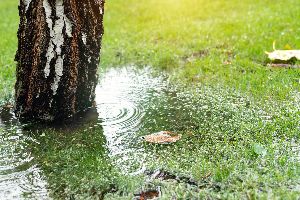
A wet basement can cause major water damage to your home and disrupt the entire household. One of the leading causes of a leaky foundation and damp lower level is hydrostatic pressure. The following guide outlines some frequently asked questions about this phenomenon so you can learn how it affects your home and how to prevent it.
A Guide to Hydrostatic Pressure
What is hydrostatic pressure?
Hydrostatic pressure is the water pressure exerted on your home by the soil surrounding the property's foundation. One square cubic foot of water weighs just over 62 lbs. When the earth around a home becomes inundated with moisture, it exerts significantly more weight on the structure, the force of which can reach up to tens of thousands of pounds. With this much pressure, there is a substantial risk of experiencing a wet basement.
How does it damage basements?
The water released by hydrostatic pressure can infiltrate the smallest foundation cracks, and it can also cause new cracks and gaps to form. If the problem is mild, your basement might become damp and leaky. On the more serious end, this underground level of your home can flood, causing damage to walls, floors, appliances, and belongings. The moisture can also attract insects and rodents. If it's not properly dried, mold and mildew can develop and cause household members to experience allergies and respiratory issues.
How can a professional prevent hydrostatic pressure issues?

Foundations are made of concrete, which is a porous material that naturally absorbs some water. As a result, there is no guaranteed way to prevent problems related to hydrostatic pressure.
However, there are steps a professional can take to minimize the risk of experiencing a wet basement. They can install an interior basement waterproofing system to prevent problems. This concealed drainage network carries water away from the foundation and deposits it on another part of the property. A French drain performs the same action but is placed around the exterior perimeter of the house. Sump pumps can also collect water in a pit in the basement before pumping it out of and away from the house.
How can I tell if hydrostatic pressure poses a threat to my foundation?
The most obvious sign of potential hydrostatic pressure problems is a wet basement. However, certain homes are more likely to develop issues than others, including those built on slopes or hillsides in regions where rainfall is common. Other susceptible properties include ones where standing water pools on lawns and structures that don't have foundation cracks or gaps visible to the naked eye.
When you need basement waterproofing to protect your home from hydrostatic pressure, trust Beaver Basement Waterproofing. For more than 20 years, they have been serving residents throughout Westby, WI, and the surrounding areas. They provide wet basement solutions, ventilation system installation, wall straightening, and indoor and outdoor drain tiling. They also offer 25-year warranties on their work. Call (608) 634-4880 to request a quote, or visit them online to learn more.
About the Business
Have a question? Ask the experts!
Send your question

